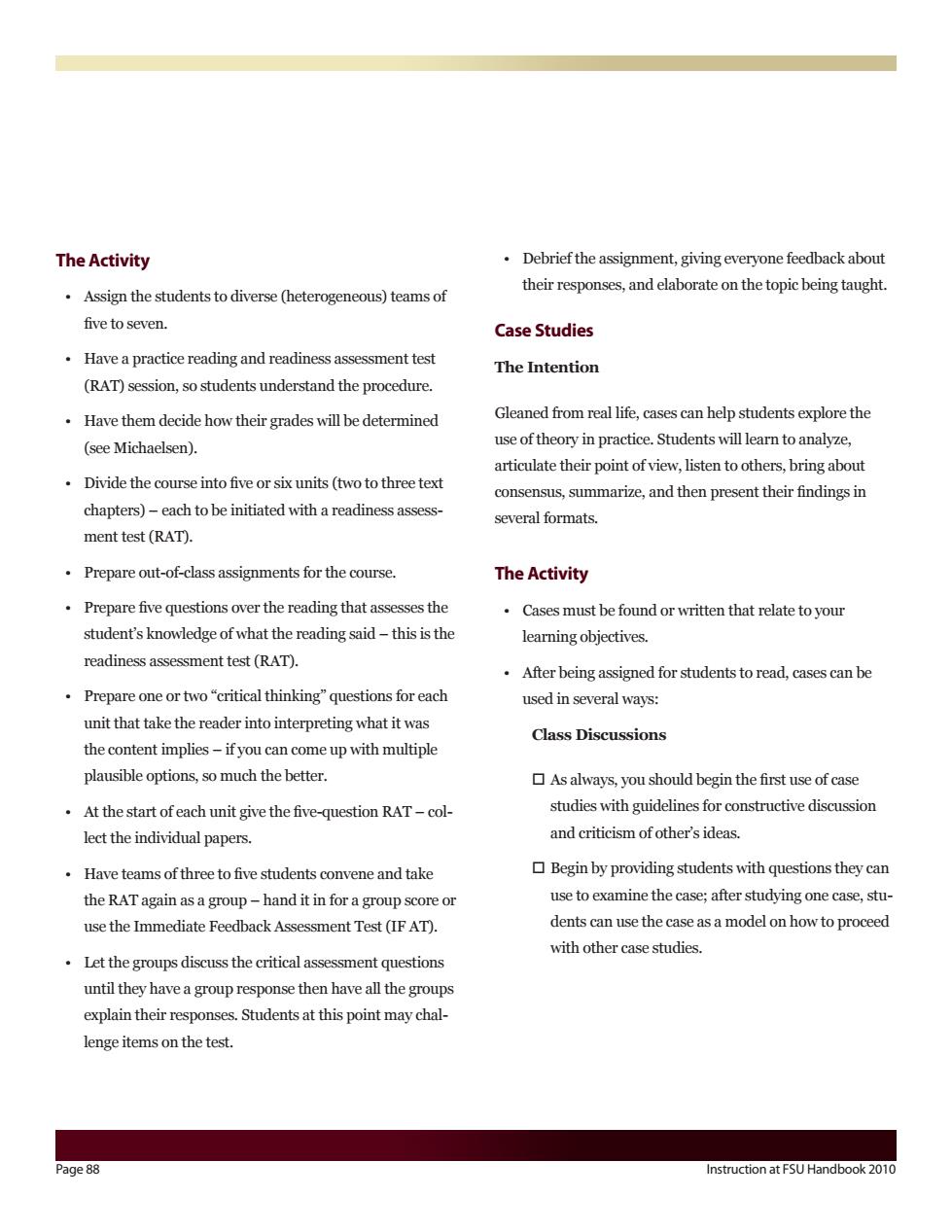正在加载图片...

The Activity .Debrief the assignment,givingeveryone feedback about .Assign the students to diverse (heterogeneous)teamso their responses,and elaborate on the topic being taught. five to seven. Case Studies Have a practice reading and readiness assessment test The Intention (RAT)session,so students understand the procedure. Have them decide how their grades will be determined Gleaned from real life,cases can help students explore the (see Michaelsen). use of theory in practice.Students will learn to analyze, articulate their point of view,listen toothers bring abou Divide the course into fiveor six units(two to three text consensus,summarize,and then present their findings in chapters)-each to be initiated with a readiness assess. several formats. ment test(RAT). Prepare out-of-class assignments for the course. The Activity Prepare five questions over the reading that assesses the Cases must be found or written that relate to your student's knowledge of what the reading said-this is the learning objectives. readiness assessment test(RAT). After being assigned for students to read,cases can be Prepare one or two"critical thinking"questions for each used in several ways: unit that take the reader into interpreting what it was Class Discussions the content implies-if you can come up with multiple plausible options,so much the better. As always,you should begin the first use of case At the start of each unit give the five-question RAT-col- studies with guidelines for constructive discussion lect the individual papers. and criticism of other's ideas. Have teams of three to five students convene and take Begin by providing students with questions they can the RATagain as a group-hand it in for a group score or use to examine the case;after studying one case,stu- use the Immediate Feedback Assessment Test(IF AT). dents can use the case as a model on how to proceed Let the groups discuss the critical assessment questions with other case studies. until they have a group response then have all the groups explain their responses.Students at this point may chal- lenge items on the test. age 88 Instruction at FSU Handbook 2010Page 88 Instruction at FSU Handbook 2010 The Activity • Assign the students to diverse (heterogeneous) teams of five to seven. • Have a practice reading and readiness assessment test (RAT) session, so students understand the procedure. • Have them decide how their grades will be determined (see Michaelsen). • Divide the course into five or six units (two to three text chapters) – each to be initiated with a readiness assessment test (RAT). • Prepare out-of-class assignments for the course. • Prepare five questions over the reading that assesses the student’s knowledge of what the reading said – this is the readiness assessment test (RAT). • Prepare one or two “critical thinking” questions for each unit that take the reader into interpreting what it was the content implies – if you can come up with multiple plausible options, so much the better. • At the start of each unit give the five-question RAT – collect the individual papers. • Have teams of three to five students convene and take the RAT again as a group – hand it in for a group score or use the Immediate Feedback Assessment Test (IF AT). • Let the groups discuss the critical assessment questions until they have a group response then have all the groups explain their responses. Students at this point may challenge items on the test. • Debrief the assignment, giving everyone feedback about their responses, and elaborate on the topic being taught. Case Studies The Intention Gleaned from real life, cases can help students explore the use of theory in practice. Students will learn to analyze, articulate their point of view, listen to others, bring about consensus, summarize, and then present their findings in several formats. The Activity • Cases must be found or written that relate to your learning objectives. • After being assigned for students to read, cases can be used in several ways: Class Discussions As always, you should begin the first use of case studies with guidelines for constructive discussion and criticism of other’s ideas. Begin by providing students with questions they can use to examine the case; after studying one case, students can use the case as a model on how to proceed with other case studies